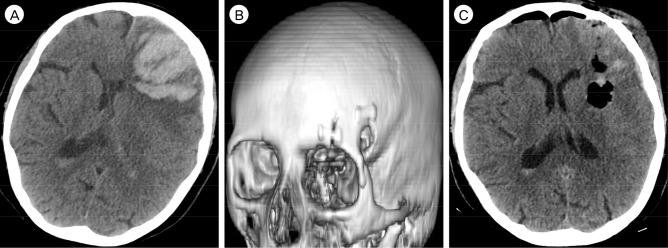J Cerebrovasc Endovasc Neurosurg.
2017 Jun;19(2):101-105. 10.7461/jcen.2017.19.2.101.
Eyebrow Incision for Surgical Evacuation of a Lobar Intracerebral Hematoma with a Novel Endoport System
- Affiliations
-
- 1Department of Neurosurgery, Barrow Neurological Institute, Phoenix, AZ, USA. daleding1234@gmail.com
- 2Department of Neurological Surgery, University of Miami, Miami, FL, USA.
- 3Department of Neurological Surgery, Rush University, Chicago, IL, USA.
- 4Department of Neurosurgery, University of Virginia, Charlottesville, VA, USA.
- KMID: 2393387
- DOI: http://doi.org/10.7461/jcen.2017.19.2.101
Abstract
- Large lobar intracerebral hemorrhages (ICHs) can cause rapid neurological deterioration, and affected patients have low rates of survival and functional independence. Currently, the role of surgical intervention in the management patients with lobar ICHs is controversial. Minimally invasive technologies have been developed which may potentially decrease the operative morbidity of ICH surgery. The aim of this case report is to describe the technical aspects of the use of a novel minimally invasive endoport system, the BrainPath (NICO, Indianapolis, IN, USA), through an eyebrow incision for evacuation of a large lobar hematoma. An 84-year-old female presented with a left frontal ICH, measuring 7.5 cm in maximal diameter and 81 cm³ in volume, secondary to cerebral amyloid angiopathy. Through a left eyebrow incision, a miniature modified orbitozygomatic craniotomy was performed, which allowed endoport cannulation of the hematoma from a lateral subfrontal cortical entry point. Endoport-assisted hematoma evacuation resulted in nearly 90% volume reduction and improvement of the patient's functional status at clinical follow-up. We found that minimally invasive endoport technology can be employed in conjunction with conventional neurosurgical skull base principles to achieve safe and effective evacuation of large lobar hematomas in carefully selected patients.
Keyword
MeSH Terms
Figure
Reference
-
1. Beynon C, Schiebel P, Bosel J, Unterberg AW, Orakcioglu B. Minimally invasive endoscopic surgery for treatment of spontaneous intracerebral haematomas. Neurosurg Rev. 2015; 7. 38(3):421–428. discussion 428. PMID: 25687253.
Article2. Broderick JP, Brott TG, Duldner JE, Tomsick T, Huster G. Volume of intracerebral hemorrhage. A powerful and easy-to-use predictor of 30-day mortality. Stroke. 1993; 7. 24(7):987–993. PMID: 8322400.
Article3. Chen CJ, Caruso J, Starke RM, Ding D, Buell T, Crowley RW, et al. Endoport-assisted microsurgical treatment of a ruptured periventricular aneurysm. Case Rep Neurol Med. 2016; 2016:8654262. PMID: 27195160.
Article4. Ding D. Surgical strategies for spontaneous basal ganglia hemorrhages. Br J Neurosurg. 2015; 6. 29(3):447. PMID: 25529967.
Article5. Ding D, Przybylowski CJ, Starke RM, Sterling Street R, Tyree AE, Webster Crowley R, et al. A minimally invasive anterior skull base approach for evacuation of a basal ganglia hemorrhage. J Clin Neurosci. 2015; 11. 22(11):1816–1819. PMID: 26142050.
Article6. Ding D, Starke RM, Webster Crowley R, Liu KC. Endoport-assisted microsurgical resection of cerebral cavernous malformations. J Clin Neurosci. 2015; 6. 22(6):1025–1029. PMID: 25769248.
Article7. Go AS, Mozaffarian D, Roger VL, Benjamin EJ, Berry JD, Borden WB, et al. Executive summary: heart disease and stroke statistics--2013 update: a report from the American Heart Association. Circulation. 2013; 1. 127(1):143–152. PMID: 23283859.8. Greenfield JP, Cobb WS, Tsouris AJ, Schwartz TH. Stereotactic minimally invasive tubular retractor system for deep brain lesions. Neurosurgery. 2008; 10. 63(4 Suppl 2):334–339. discussion 339-40. PMID: 18981840.
Article9. Hemphill JC 3rd, Bonovich DC, Besmertis L, Manley GT, Johnston SC. The ICH score: a simple, reliable grading scale for intracerebral hemorrhage. Stroke. 2001; 4. 32(4):891–897. PMID: 11283388.10. Liotta EM, Prabhakaran S. Warfarin-associated intracerebral hemorrhage is increasing in prevalence in the United States. J Stroke Cerebrovasc Dis. 2013; 10. 22(7):1151–1155. PMID: 23287421.
Article11. Mendelow AD, Gregson BA, Rowan EN, Murray GD, Gholkar A, Mitchell PM, et al. Early surgery versus initial conservative treatment in patients with spontaneous supratentorial lobar intracerebral haematomas (STICH II): a randomised trial. Lancet. 2013; 8. 382(9890):397–408. PMID: 23726393.
Article12. Morgenstern LB, Hemphill JC 3rd, Anderson C, Becker K, Broderick JP, Connolly ES Jr, et al. Guidelines for the management of spontaneous intracerebral hemorrhage: a guideline for healthcare professionals from the American Heart Association/American Stroke Association. Stroke. 2010; 9. 41(9):2108–2129. PMID: 20651276.13. Mould WA, Carhuapoma JR, Muschelli J, Lane K, Morgan TC, McBee NA, et al. Minimally invasive surgery plus recombinant tissue-type plasminogen activator for intracerebral hemorrhage evacuation decreases perihematomal edema. Stroke. 2013; 3. 44(3):627–634. PMID: 23391763.
Article14. Newell DW, Shah MM, Wilcox R, Hansmann DR, Melnychuk E, Muschelli J, et al. Minimally invasive evacuation of spontaneous intracerebral hemorrhage using sonothrombolysis. J Neurosurg. 2011; 9. 115(3):592–601. PMID: 21663412.
Article15. Przybylowski CJ, Ding D, Starke RM, Webster Crowley R, Liu KC. Endoport-assisted surgery for the management of spontaneous intracerebral hemorrhage. J Clin Neurosci. 2015; 11. 22(11):1727–1732. PMID: 26238692.
Article
- Full Text Links
- Actions
-
Cited
- CITED
-
- Close
- Share
- Similar articles
-
- Supraorbital Endoscopic Evacuation for Traumatic Intracerebral Hematomas in the Frontal Lobe
- The Use of Urokinase in Traumatic Intracerebral Hematoma Treatment
- Surgical Management of the Hypertensive Intracerebral Hemorrhage
- Stereotaxic Evacuation Using Pelorus System vs Conventional Craniotomy for Spontaneous Intracerebral Hematoma
- Delayed CT Guided Stereotaxic Evacuation of Hypertensive Intracerebral Hematoma


